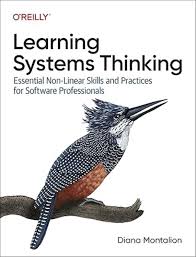Executive Summary
Organizations face accelerating change, increased complexity, and interdependent challenges. Systems Thinking provides the frameworks to understand, design, and intervene in complex environments. This white paper presents practical tools and strategies drawn from Learning Systems Thinking, O’Reilly’s adaptive learning framework, and Cabrera Research’s mental model theory.
Learning Systems Thinking for Organizational Success
A Framework for Navigating Complexity with KeenComputer.com and IAS-Research.com
Executive Summary
Organizations face accelerating change, increased complexity, and interdependent challenges. Systems Thinking provides the frameworks to understand, design, and intervene in complex environments. This white paper presents practical tools and strategies drawn from Learning Systems Thinking, O’Reilly’s adaptive learning framework, and Cabrera Research’s mental model theory.
It also outlines how KeenComputer.com and IAS-Research.com partner to support digital system integration, organizational development, and advanced simulation modeling—helping businesses become adaptive, future-ready systems.
1. Introduction to Systems Thinking
Systems thinking helps leaders understand the interrelationships and patterns that drive behavior in complex systems. It emphasizes:
- Feedback loops and delays
- Mental models and behavior patterns
- Whole-system design thinking
2. Why Systems Thinking Matters
Key Challenges Addressed:
- Fragmented decision-making across departments
- Unintended consequences of isolated interventions
- Difficulty sustaining long-term strategy in complex systems
Benefits:
- Alignment across departments
- Root cause analysis and long-term problem solving
- Improved decision-making under uncertainty
3. Core Tools and Frameworks
- Behavior Over Time Graphs (BOTG): Visualizing trends over time
- Causal Loop Diagrams (CLD): Mapping reinforcing and balancing feedback loops
- Mental Model Mapping: Surfacing hidden assumptions
- System Archetypes: Recognizing repeated failure patterns like “Fixes that Fail” or “Shifting the Burden”
4. O'Reilly’s Context-Aware Learning Framework
A learning architecture based on:
- Ecosystem mapping
- Interdependency modeling
- Goal alignment and dynamic feedback loops
It supports learning organizations by integrating systems thinking into operations, project management, and digital development.
5. Implementation Roadmap
- Map systemic challenges and interdependencies
- Train teams using real-world models and simulations
- Embed system thinking into strategic reviews
- Evaluate interventions using system dynamics and metrics
6. SWOT Analysis: Systems Thinking for Organizations
|
Strengths |
Weaknesses | |
|---|---|---|
|
Holistic decision-making framework |
Requires mindset and culture shift |
|
|
Identifies root causes and leverage points |
Initial learning curve for technical tools (CLD, BOTG) |
|
|
Breaks silos and fosters collaboration |
May need integration into existing KPIs and dashboards |
|
|
Enables long-term planning over short-term firefighting |
Requires time and cross-functional engagement |
|
|
Opportunities |
Threats | |
|
Integration with digital tools like ERP, CRM, and AI dashboards |
Resistance from leadership tied to linear models |
|
|
Training cross-functional teams on adaptive decision-making |
Misapplication of tools without coaching or facilitation |
|
|
Creating learning ecosystems and innovation labs |
Overcomplexity if systems mapping is not scoped effectively |
|
|
Leveraging AI to detect hidden systemic risks |
Lack of buy-in from short-term focused stakeholders |
|
Strategic Insight: Organizations that combine systems thinking with technology and analytics (as provided by KeenComputer.com and IAS-Research.com) can overcome weaknesses and threats—transforming complexity into opportunity.
7. How KeenComputer.com Can Help
|
Area |
Solutions |
|---|---|
|
Digital Systems Design |
Integrate system maps into dashboards, CRMs, and workflows |
|
Simulation Labs |
Develop digital labs for feedback loop testing and intervention modeling |
|
Team Enablement |
Deliver structured workshops with causal models, BOTGs, and archetypes |
|
Adaptive Infrastructure |
Build tools to monitor system KPIs and dynamic performance metrics |
8. How IAS-Research.com Can Help
|
Area |
Solutions |
|---|---|
|
Advanced System Dynamics |
Build simulation models using real-time and historical data |
|
Research and Innovation |
Apply scientific modeling, AI, and cybernetics to system design |
|
Knowledge Transfer |
Support white papers, strategy pilots, and research-driven transformation |
|
AI-Augmented Systems |
Deploy RAG + LLMs to detect weak signals, trends, and risks in systems |
9. Case Study: Logistics Optimization through Systems Thinking
Problem: A logistics company experienced delivery delays and internal blame culture.
Intervention:
- CLDs identified reinforcing loops between pressure and error rates.
- System dashboard integration via KeenComputer.com.
- Simulation of new delivery strategies with IAS-Research.com.
Outcomes:
- 19% delivery improvement.
- 25% morale improvement.
- Reduced firefighting; improved forward planning.
10. Conclusion
Systems thinking empowers organizations to lead change, not react to it. By building shared mental models, visualizing feedback, and simulating outcomes, teams make better decisions—faster and together.
With KeenComputer.com and IAS-Research.com, you gain not just knowledge, but implementation power—from system maps to AI-backed decision systems.
11. Next Steps
|
Action |
Partner |
Benefit |
|---|---|---|
|
Discovery Workshop |
KeenComputer.com |
Identify key system dynamics and pain points |
|
Simulation Pilot |
IAS-Research.com |
Model the real-world effects of change |
|
Executive Alignment Sessions |
Both |
Build buy-in and strategic capability |
|
Dashboard Integration |
KeenComputer.com |
Monitor systems with live feedback loops |
References
- Diana Montalion. Learning Systems Thinking. https://learningsystemsthinking.com
- Pegasus Communications. Systems Thinking Tools. https://thesystemsthinker.com
- Cabrera Research. Systems Thinking White Paper. https://help.cabreraresearch.org
- O’Reilly Context-Aware Systems Workshop.
- Senge, P. M. (2006). The Fifth Discipline: The Art and Practice of the Learning Organization.
